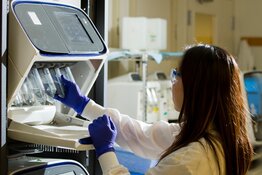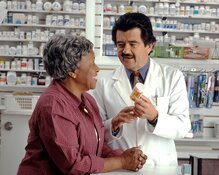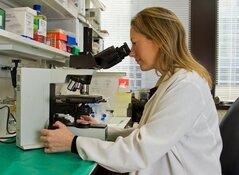The Life Sciences Report: Let's start with ContraVir Pharmaceuticals Inc.'s (CTRV:NASDAQ) lead product. What is FV-100?
James Sapirstein: FV-100 is an antiviral compound that is specific for a virus called herpes zoster, also known as varicella zoster or the chickenpox virus. When a kid gets chickenpox, a rash pops up, but the pox is not painful. When adults get it the virus is called shingles, and it is very painful. The nerve pain is called postherpetic neuralgia (PHN). Other antivirals used to treat shingles work against several types of herpes virus, including herpes simplex 1 and herpes simplex 2, but they don't have much specificity for herpes zoster or pain.
Our product, FV-100, does not work against the other herpes viruses. It is dialed in specifically for herpes zoster, and it targets the dorsal root ganglion of the nerve, which the virus inhabits. It helps stop replication of the virus in the dorsal root ganglion. One of the nice things about this product is that it can be dosed at 400 mg once a day. The current gold standard in shingles treatment is valacyclovir, dosed at one gram three times a day; the other antivirals are dosed four or five times a day.
"The pain-reducing indication we are chasing is a disease-modifying opportunity."
All the antivirals reduce the shingles rash eventually. But the pain can last a few days or months, and even years. Importantly, our Phase 2 study of FV-100 indicates a significant reduction in the level of pain associated with shingles. The current standard of care for pain management is acetaminophen or ibuprofen. If the pain is severe, a doctor will prescribe a Lidoderm (lidocaine) patch or a narcotic. If the pain is long term, a doctor might prescribe a neuropathic treatment, such as Lyrica (pregabalin). FV-100 will be a one-stop shop.
TLSR: Are adults who got chickenpox as a child immune to shingles?
JS: Anyone can get shingles. Herpes zoster is a latent virus; it sleeps when the immune system is strong. But the immune function weakens as people age, allowing the herpes to present as shingles. Shingles mostly affects people over age 65, but plenty of younger people get it, too.
TLSR: Where is FV-100 in terms of clinical trials?
JS: FV-100 is entering Phase 3 at the end of this quarter. The FDA is allowing us to go directly from Phase 2a into Phase 3 because a) the agency felt we had collected enough safety data already, and b) the pain-reducing indication we are chasing is a disease-modifying opportunity.
We are skipping Phase 2b, which will save us about two and a half years of development and $25–26M in capital expense.
The Phase 3 trial is called 007; it will include 825 patients from 200 recruitment sites. A patient must have active shingles to enter the trial, and report within 72 hours. It is not an easy trial to recruit. We advertise on TV, radio and social media, and we target urgent care centers and shingles centers of excellence in the south, southeast and southwestern U.S., which have the most elderly populations.
TLSR: What happens when a patient with shingles calls?
JS: We ask him or her to come in to the closest clinical site for enrollment. The trial is for 120 days. The investigator walks the patient through the process, starting with blood work at the clinic. When the patient has been medicated for seven days, we start daily measurements with a handheld device to get readings on PHN reduction.
TLSR: Is there any way to have a control group?
JS: There cannot be a control group, because there is no placebo. We have three groups of patients. One group gets FV-100 400 mg once a day; another group gets FV-100 400 mg twice a day, to see if we can reduce PHN by better than 39%, which was the outcome from our Phase 2 trial. The third group receives valacyclovir, which is the standard of care. There is a pain algorithm, and depending on pain thresholds, the doctor can adjust medication.
TLSR: How long do you anticipate the pivotal Phase 3 stage will last?
JS: Two years. We will then launch another trial to get registration. If all goes well, FV-100 will go to market in four years or less.
TLSR: What is the market for FV-100?
JS: FV-100's shingles market would amount to about 20M prescriptions annually in the United States. The disease is spread out evenly around the rest of the world, but in the westernized world, where we have the shingles vaccine for kids, we are seeing an increase of adult shingles, believe it or not.
TLSR: Why is there this increase?
JS: Because most children in the U.S. are vaccinated for chickenpox, they have not picked up the antibodies to herpes zoster, or chickenpox virus. As adults, they are more susceptible to shingles than previous generations, where children had chickenpox.
TLSR: How does the shingles vaccine, which is currently available, factor into this market?
JS: The only shingles vaccine on the market is owned by Merck & Co. Inc. (MRK:NYSE). Unfortunately, it has about a 50% failure rate. It is not covered under managed care, so patients may pay up to $300 out of pocket for the vaccine. GlaxoSmithKline (GSK:NYSE) has a shingles vaccine in a Phase 3 trial. Glaxo is quoting better numbers than the Merck vaccine, but Merck also had heady numbers when it launched, and now it's at a 50% failure rate. Oral therapeutic products are more reliable than vaccines that may or may not take.
TLSR: Does FV-100 have a preventive application?
JS: We are not looking at an indication for prevention. However, the FDA has told us that if we achieve a strong decrease in the incidences of PHN—well over 50%—it might consider the drug as a preventive.
TLSR: ContraVir has another product in the regulatory pipeline, CMX157. What is that story?
JS: CMX157 was licensed from Chimerix Inc. (CMRX:NASDAQ). It is a lipid analogue of tenofovir diphosphate, which up until very recently was the highest-selling antiviral in the world. It is a $5B/year product. Gilead Sciences Inc.'s (GILD:NASDAQ) branded name for tenofovir is Viread. I launched it for HIV when I was with Gilead.
"We assess that CMX157 is 200 times more potent than the standard of care, tenofovir."
ContraVir has intellectual property (IP) on CMX157 through 2031. We are still testing it, but we have already demonstrated better tissue and blood concentration versus Gilead's tenofovir. We are not looking at it for HIV, only for hepatitis B (HBV). It targets both HIV and HBV, but there is not a lot of room for a new entry in the HIV space, whereas HBV is wide open.
TLSR: And where is CMX157 in clinical trials?
JS: CMX157 is in the Phase 1b/2 trial stage. We have to do a multiple ascending dose trial to get the right dose so that we can proceed into Phase 2 and go head-to-head against Gilead's Viread. We are planning to do that at the end of 2015.
TLSR: How large is the hepatitis B market for CMX157?
JS: There are 350M chronic hepatitis B patients, according to the World Health Organization (WHO) and others. That's huge.
TLSR: How does hepatitis B spread?
JS: Most cases occur via mother-to-child transmission, with the vast majority of patients in Asia and Eastern Europe. The United States has had a hepatitis B vaccine for children for a very long time, so we do not see it in kids any more. Five years ago, an adult vaccine was made available. It's a series of three vaccines, and most people do not bother to get it.
TLSR: Will CMX157 cure hepatitis B?
JS: It is not a cure. The story is that Gilead's version of tenofovir is the best product on the market; it holds off the infection without curing it. But "cure" is relative; HIV patients are almost cured. Using different combinations of therapy, HIV patients can have a normal life; living to be 70 or 80 years old is not out of the question. Diabetics die earlier than that. Everyone's been up in arms about the price of Gilead's Sovaldi, but it cures hepatitis C in six to eight weeks. Hepatitis B awaits the cure, which is going to be combination therapy—a cocktail. We assess that CMX157 is 200 times more potent than the standard of care, tenofovir. And it has less toxicity and fewer side effects. It is in line to replace Gilead's Viread.
Several companies are producing or developing products to treat hepatitis B. JP Morgan Chase & Co. (JPM:NYSE) did a hepatitis B deal. A small company named OnCore Biopharma Inc., which has three preclinical assets for hepatitis B, was acquired by Tekmira Pharmaceuticals Inc. (TKMR:NASDAQ; TKM:TSX) for $750M.
TLSR: Given that a lot of your market for CMX157 is in Third World countries, what kind of pricing regime would be attached to this?
JS: It will vary according to the different combinations of products that reach the market and what governments are willing to pay.
TLSR: Why was ContraVir spun off from Synergy Pharmaceuticals Inc. (SGYP:NASDAQ) in May 2013?
JS: ContraVir's shingles treatment is an antiviral drug. It was discovered by Chris McGuigan, who is on the board of Synergy Pharmaceuticals. To promote FV-100, Chris started FermaVir Pharmaceuticals LLC, which merged with Inhibitex Inc. Bristol-Myers Squibb Co. (BMY:NYSE) purchased Inhibitex for $2.5 billion ($2.5B), but shingles is not a strategic focus for Bristol, so the company put FV-100 out to bid. Encouraged by McGuigan, Synergy Pharmaceuticals licensed it. But Synergy is focused on gastrointestinal disease—not on infectious disease—so it decided to spin off the antiviral product, creating ContraVir.
TLSR: And did Synergy Pharmaceuticals advance capital to fund ContraVir?
JS: Synergy loaned us $500,000 ($500K), and we did a PIPE for another $2.8 million ($2.8M). Synergy shareholders received ContraVir Pharmaceuticals shares, which means that ContraVir started out with about 4,500 shareholders.
TLSR: Considering that ContraVir Pharmaceuticals does not yet have a revenue stream, how are you financing operations?
JS: We raised money in a Series A last October. We also raised $9M with a side note or PIPE of $3.5M. That was a private placement with European investors. We have $7.6M in the bank. We are in line for another PIPE. And we could file a broad-range financing, if needed.
TLSR: What's your burn rate?
JS: It just increased to $1M a month. We were holding steady about $300K a month, but going into Phase 3, the burn rate jumped. To get through the next four years we will have to raise more money.
TLSR: Why should investors have confidence in ContraVir's management team?
JS: John Sullivan-Bolyai is our chief medical officer. He came to us from Merck & Co. after the acquisition of Idenix Pharmaceuticals Inc. (IDIX:NASDAQ). John is a leading hepatitis expert. He's also worked with Roche Holding AG (RHHBY:OTCQX) and Valeant Pharmaceuticals International Inc. (VRX:NYSE; VRX:TSX).
"We have two nicely progressing middle- to late-stage assets."
I am a pharmacist with an MBA, and I've been in the virology business for 31 years. I've spent seventeen years in big pharma: Eli Lilly and Co. (LLY:NYSE), Hoffmann–La Roche, Bristol-Myers Squibb. I worked with Gilead; as I mentioned, I launched Gilead's Viread, the tenofovir product that ContraVir is now challenging.
I've been a part of 23 drug launches in my career, leading six of them globally. At Serono Laboratories Inc., I ran the U.S. group in metabolic and endocrinology, with several drug launches in biologics at the time. In the world of venture capital, I've been part of three start-ups. The first one went public two weeks ago: It is called Tobira Therapeutics Inc. (TBRA:NASDAQ). At another turnaround company called Alliqua Therapeutics at Alliqua Inc., I secured a 14x return for my investors in a year. I joined ContraVir in March 2014. I have extensive clinical, marketing and commercial experience. During my career, I've raised well over $100M.
TLSR: I noticed that ContraVir's stock has a 52-week high of $5.15/share and a 52-week low of $0.65/share. What accounts for the spread?
JS: We started at a very low price. When I got the patent extension for CMX 157, our share price rose to $5.16/share for about two seconds. We've been hovering in the $3.50–4/share range for the last three months. The point is that we got up to over $4/share naturally. Then we uplifted to NASDAQ. Our volume is steady in the 20,000–25,000 share range; that's because two months ago, I announced a financing. Most investors realize that we will have to finance the company eventually. People are taking a wait-and-see attitude, so there is not a lot of trading volume.
TLSR: I see that a number of analysts and others are initiating coverage with Outperform ratings. How has that affected your business outlook?
JS: Noble Financial Capital Markets put out a very positive report. I am talking to a lot of investors about their risk appetites. Everyone has the Noble Financial Capital Markets report, and it's been very well received. All of them know that ContraVir is undervalued. They want to participate if we do a larger financing.
TLSR: Is there a danger of ContraVir's stock getting watered down?
JS: We only have about 3.5–4M shares floating, so there is not much chance of dilution, unless we put a lot more shares out there for purchase. I shall do my best to not dilute investors.
TLSR: Why should retail investors be interested in ContraVir at this stage of the firm's development?
JS: Our market cap is $81M. We have two nicely progressing middle- to late-stage assets. We are in our infancy, so the stock is cheap. Once we finance the company, business will take off, as will the share price. Noble Financial Capital Markets said we should be in the $6–6.50/share price range, so the investors who buy now will get a good return.
I am also in discussions with several companies about licensing several products. One is an antiviral. I am not at liberty to say more than that.
TLSR: Thanks for your time, James.
CEO James Sapirstein, RPh, MBA, brings more than 30 years of pharmaceutical industry experience to ContraVir Pharmaceuticals Inc. His career began at Eli Lilly; he has also held positions with Hoffmann-LaRoche, Bristol Myers Squibb, Gilead Sciences, Serono Laboratories, and the privately held firm Tobira Therapeutics. Before joining ContraVir, he was CEO of Alliqua Therapeutics at Alliqua Inc., where he helped lead the transformation of transdermal wound care and drug delivery technology into a premier wound care organization. He also developed the growth strategies for the organization and was responsible for several key licensing opportunities that led to an increased return on investment for all of the shareholders. Mr. Sapirstein holds board positions on BIONJ, BIO's ECSGB, Panther Biotechnology Inc., Cortex Pharmaceuticals Inc. and Clinical Supplies Management.
Read what other experts are saying about:
Want to read more Life Sciences Report interviews like this? Sign up for our free e-newsletter, and you'll learn when new articles have been published. To see a list of recent interviews with industry analysts and commentators, visit our Interviews page.
DISCLOSURE:
1) Peter Byrne conducted this interview for Streetwise Reports LLC, publisher of The Gold Report, The Energy Report and The Life Sciences Report, and provides services to Streetwise Reports as an independent contractor. He owns, or his family owns, shares of the company mentioned in this interview: None.
2) ContraVir Pharmaceuticals Inc. paid Streetwise Reports to conduct, produce and distribute the interview.
3) James Sapirstein had final approval of the content and is wholly responsible for the validity of the statements. Opinions expressed are the opinions of James Sapirstein and not of Streetwise Reports or its officers.
4) The interview does not constitute investment advice. Each reader is encouraged to consult with his or her individual financial professional and any action a reader takes as a result of information presented here is his or her own responsibility. By opening this page, each reader accepts and agrees to Streetwise Reports' terms of use and full legal disclaimer.
5) From time to time, Streetwise Reports LLC and its directors, officers, employees or members of their families, as well as persons interviewed for articles and interviews on the site, may have a long or short position in securities mentioned. Directors, officers, employees or members of their families are prohibited from making purchases and/or sales of those securities in the open market or otherwise during the up-to-four-week interval from the time of the interview until after it publishes.





































